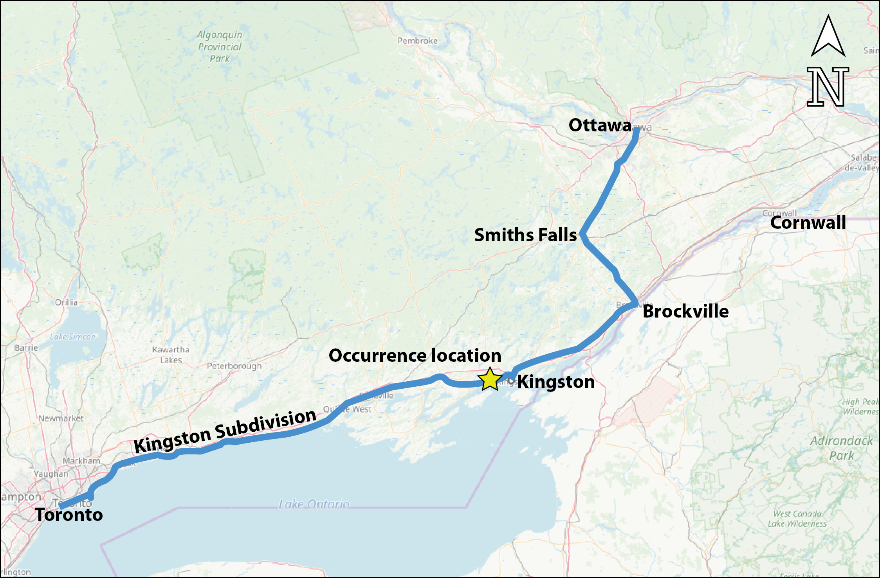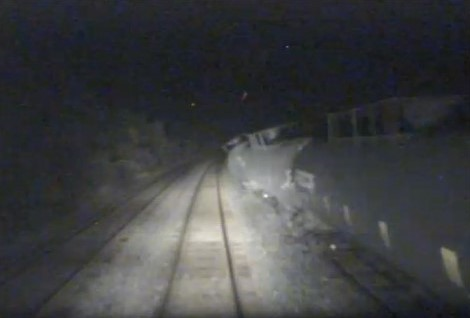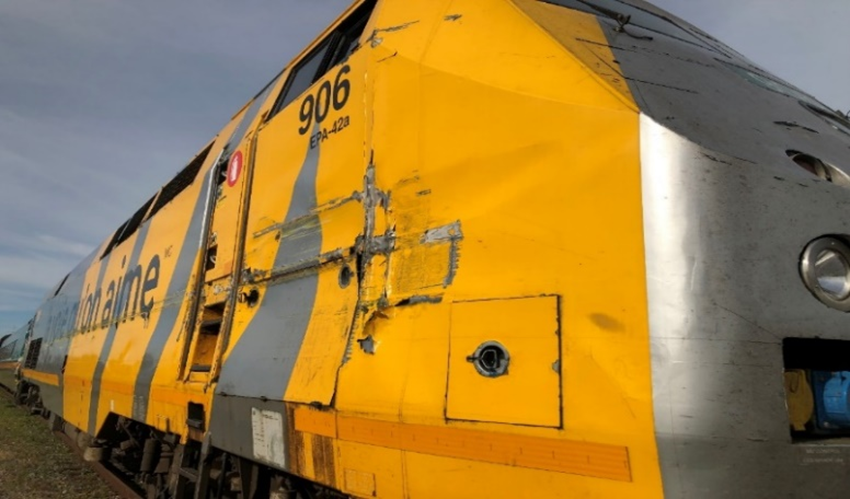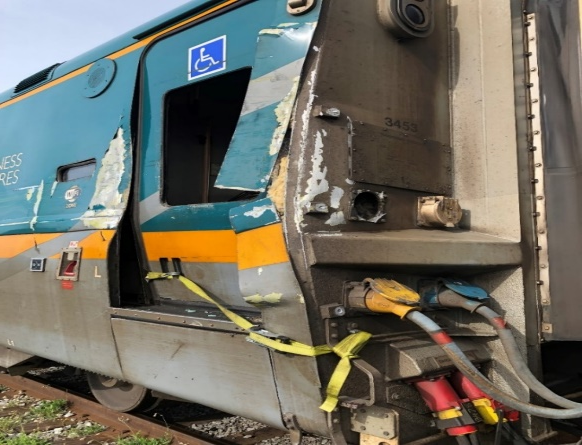Main-track train collision with standing cut of cars foul of the main track
VIA Rail Canada Inc.
Ernestown, Ontario
The Transportation Safety Board of Canada (TSB) investigated this occurrence for the purpose of advancing transportation safety. It is not the function of the Board to assign fault or determine civil or criminal liability. This report is not created for use in the context of legal, disciplinary or other proceedings. See Ownership and use of content. Masculine pronouns and position titles may be used to signify all genders to comply with the Canadian Transportation Accident Investigation and Safety Board Act (S.C. 1989, c. 3).
The occurrence
On 05 September 2019, a VIA Rail Canada Inc. (VIA) operating crew reported for duty at 1640Footnote 1 in Toronto, Ontario, for VIA passenger train 48 (VIA 48), which had been ordered for 1710. The eastbound train was to operate from Toronto (Mile 333.80) on the Metrolinx-owned portion of the Kingston Subdivision (Mile 333.80 to Mile 313.9), then travel on the Canadian National Railway Company (CN)–owned portion of the Kingston Subdivision to Brockville, Ontario (Mile 313.9 to Mile 125.6).
From Brockville, VIA 48 was to operate over the VIA Rail Brockville Subdivision to Smiths Falls, Ontario; over the VIA Rail Smiths Falls Subdivision to Federal, Ontario; and over the VIA Rail Beachburg Subdivision to Ottawa, Ontario (Figure 1).
VIA 48 was powered by a single locomotive and had 1 business light, rapid, comfortable (LRC) car and 3 passenger coaches. It weighed about 370 tons, was 409 feet long, and was carrying 112 passengers and 9 VIA employees (2 VIA operating crew members and 7 on-train service employees). The operating crew of VIA 48 consisted of 2 locomotive engineers (LE): an operating LE and an in-charge LE who assumed the role of conductor. The crew members were qualified for their positions, met fitness and rest requirements, and were familiar with the territory.
VIA 48 encountered a Stop signal indication at Ernestown, Ontario (Mile 187.70), and stopped on the south main track. At about 2110, VIA 48 received a Clear signal indication, began to accelerate, and continued eastward.
At 2115, while VIA 48 was proceeding at 62 mph on the south main track and rounding a right-hand curve, the operating crew observed 2 tank carsFootnote 2 on track KN-03, which was adjacent to and south of the main track, leaning to the north and foul of the main track at Mile 186.68 (Figure 2).
Just moments before the arrival of VIA 48, the crew of CN road switching assignment L51931-05 (CN 519) was shoving cars into track KN-04. The assignment struck the cars on track KN-03, pushing them foul of the main track.
The VIA 48 operating crew initiated an emergency brake application, immediately followed by an emergency radio broadcast, as required. However, VIA 48 was unable to stop before side-swiping the tank cars.
About 9 seconds later, westbound VIA passenger train 669, with 170 passengers on board, which was proceeding on the north main track at 95 mph, initiated a brake application and passed VIA 48 while travelling at 89 mph.
The two VIA trains did not collide or derail, and no injuries were reported. However, as a result of the side-swipe collision, the entire south side of the VIA 48 train received significant damage (figures 3 and 4). The tank car jackets and running gear of the 2 tank cars were also damaged.
VIA provided a replacement passenger train and operating crew for the passengers of VIA 48. Local emergency fire and medical services personnel helped the VIA employees to safely transfer all passengers from VIA 48 to the replacement passenger train.
At the time of the collision, it was dark, the temperature was 15 °C with scattered clouds, winds were from the north-northeast at 19 km/h, and visibility was 32 km.
Subdivision information
The Kingston Subdivision extends from Dorval East, Quebec (Mile 10.3), to Toronto, Ontario (Mile 333.80). The track in the vicinity of the collision consists of double main track. Train movements in the area are governed by the centralized traffic control system (CTC) as authorized by the Canadian Rail Operating Rules (CROR), and supervised by a rail traffic controller (RTC) located in Montréal, Quebec. An average of 18 freight trains per day operate in the area. At the time of the accident, VIA was operating a daily average of 33 passenger trains on weekdays and slightly fewer on weekends.
The track in the vicinity of the collision is Class 5 according to the Transport Canada (TC)–approved Rules Respecting Track Safety, otherwise known as the Track Safety Rules (TSR). The authorized timetable speed in the area of the collision is 100 mph for passenger trains, with a 90 mph permanent slow order when any portion of the movement is on non-tangent track, and 60 mph for freight trains. The track consisted of 136-pound continuous welded rail. The track was in good condition and met the requirements of the TSR.
CN’s <em>Canadian Rail Operating Rules</em> Rule 115 – Shoving Equipment
CN’s CROR Rule 115, Shoving Equipment, states in part:
- When equipment is shoved by an engine or is headed by an unmanned remotely controlled engine, a crew member must be on the leading piece of equipment or on the ground, in a position to observe the track to be used and to give signals or instructions necessary to control the move.
EXCEPTION: A crew member need not be so positioned when the portion of the track to be used is known to be clear. However, equipment not headed by an engine must not approach to within 100 feet of any public, private or farm crossing unless such crossings are protected as described in Rule 103 paragraph (b) or (g).- Known to be clear is defined as seeing the portion of the track to be used as being clear and remaining clear of equipment, track units, blue or red signals, derails, switches, and as having sufficient room to contain equipment being shoved. This determination must be made by a qualified employee who can observe the track and has radio contact with the employee controlling the movement. Where a track that has been seen to be clear and no access to that track is possible by another movement, the track may be considered as “known to be clear”.Footnote 3
Crew of CN 519
The crew of CN 519 comprised a locomotive engineer (LE), a conductor, and an assistant conductor. The crew members were qualified for their positions, met fitness and rest requirements, and were familiar with the territory.
The LE began his career in Capreol, Ontario, and had qualified as a conductor in March 2013. After working as a conductor for just over 5 years in Capreol; Hornepayne, Ontario; and Belleville, Ontario; he was trained as an LE and qualified in February 2019. Since April 2016, the LE had worked only out of Belleville and had worked the 518/519 assignment 15 times.
The conductor was hired in March 2018. He was trained in MacMillan Yard in Toronto and had qualified as a conductor in October 2018. Since that time, the conductor had worked out of Belleville on through freight trains and had worked the 518/519 assignment 9 times. The conductor had limited experience switching at Ernestown Yard. He had worked in the yard the previous week and did not use track KN-04 at that time. The conductor did not know the length of track KN-04 before arriving in Ernestown.
The assistant conductor was hired in June 2018 and had trained and qualified as a conductor in January 2019 at MacMillan Yard in Toronto. Since qualifying, the assistant conductor had worked out of Toronto, until April 2019, when he transferred to Belleville. The assistant conductor mostly worked on through freight trains and had worked the 518/519 assignment 4 times. He had little experience switching at Ernestown Yard.
Switching activities of the crew of CN 519 at Ernestown
The collision occurred adjacent to industrial track near Ernestown. Before the arrival of VIA 48, the crew of CN 519 was in the process of setting off cars at Ernestown and had just cleared the main track to provide VIA 48 with a permissive signal through Ernestown.
The crew of CN 519 had arrived from Belleville to set off its cars at the Ernestown industrial siding using the main-track switch at Mile 186.68. CN 519 was equipped with 2 locomotives and had 17 loaded cars and 1 empty car, weighed 2157 tons, and was 1185 feet long.
CN 519’s crew had originally planned to set off the 18 cars into siding track KN-03, but the track was already occupied with tank cars. Subsequently, they decided to set off the 18 cars into track KN-04, which was adjacent to track KN-03, and joined with track KN-03 at about its mid-point.
Before commencing work, the crew performed a job briefing. At about 2100, in preparation for the set-off, the assistant conductor remained at the main-track switch, and the conductor walked to within 3 to 4 car lengthsFootnote 4 of the west end of track KN-04, using a lantern for light because there was no other source of lighting in the surrounding area. He estimated the number of cars that track KN-04 could hold, confirmed that the track was clear, and determined that there was sufficient room to place the cars being shoved.
The conductor told the LE that there was enough room in track KN-04. Without observing the point of the movement (i.e., the progress of the lead car), the conductor walked to the east end of the track while transmitting distance in car lengths to the LE. The conductor instructed the LE to stop the movement once the locomotives were clear of the lead track in track KN-04. Once CN 519 was clear of the main track, the assistant conductor restored and locked the main-track switch. VIA 48 then received a Clear signal indication at Ernestown, which allowed it to proceed up to the maximum authorized subdivision speed of 100 mph.
The CN 519 crew were unaware that their movement had been shoved through the west end of track KN-04 into the side of 2 tank cars standing on track KN-03, causing the cars to derail to the north, and foul of the Kingston Subdivision south main track (Figure 5).
CN operating crew training
Conductor trainees complete 5 weeks of in-class training followed by 2 weeks of field-intensified training.Footnote 5 During the in-class training, trainees must successfully complete several modules of computer-based training. CN CROR training, including Rule 115, is instructor-led with in-class discussion. The training material on Rule 115 defines the rule and the exception, but does not explain how to determine if there is sufficient room for cars in a track.
During the 2 weeks of field-intensified training, trainees practise 1 or 2 switching exercises along with radio communication. The exercises do not cover how to calculate track length or teach trainees which situations are appropriate for applying the exception to Rule 115. Generally, trainees leave the training centre with a clear understanding of the CROR, but they might not have the same understanding of any exceptions to the CROR that may apply.
After successfully completing this training, trainees must perform 3 weeks of familiarization in a yard and a minimum of 45 training trips while under the supervision of a qualified conductor. During this training, opportunities for trainees to practise the application of Rule 115 and to estimate the length of cuts of cars on their own are sometimes limited, even though this is a necessary skill to ensure that they know how to calculate whether sufficient room is available when applying the exception to Rule 115.
Interpretation and distance calculation related to Rule 115
Humans’ ability to estimate distance between 2 objects varies, and is influenced by a number of factors, including individual differences in spatial abilities, knowledge of the area, and distance estimation method.Footnote 6,Footnote 7 Distance estimation is particularly prone to error in reduced visual conditions. For example, in the absence of visual depth cues (such as at night), observers typically underestimate how far away landmarks are from themselves.Footnote 8,Footnote 9
As he had done previously when it was not known whether there was sufficient room, the conductor estimated the length of the track by walking and counting the number of cars the track could hold. He based this on a typical car length of 50 feet and used the cars that were located in the adjacent track KN-03 as a reference for car length. He understood “sufficient room” to mean that the track was long enough to contain the 18-car set-off plus 2 car lengths. However, he was unaware that the cars on track KN-03 were an average of 2 feet shorter than the cars on CN 519.
Track KN-04 was approximately 1300 feet long and CN 519 was approximately 1185 feet long. This left approximately 115 feet of buffer space, or just over 2 car lengths. Because the conductor did not want to leave the locomotives foul of the east switch for KN-04, he stopped the movement when the locomotives were clear of the switch by about 3 car lengths (150 feet). In this case, with only about a year of operating experience (mostly in through freight service), the conductor lacked sufficient experience to properly estimate the length of the track required to safely apply the exception to CROR Rule 115.
Instead of providing point protection by riding the lead car while shoving cars back into track KN-04, the conductor chose to apply the exception to CROR Rule 115 because he knew that the track to be used was clear and he believed it had sufficient room to contain the movement.
Safety action taken
Following this accident, Transport Canada (TC) conducted an inspection and issued a letter of non-compliance to Canadian National Railway (CN) for non-compliance with Rule 115 of the Canadian Rail Operating Rules (CROR).
Safety messages
When there is not enough length of track available to set out cars, it is important that crews ride the lead car of a movement.
When applying the exception to CROR Rule 115, it is important that operating employees consider a sufficient safety margin when estimating the length of track available.
It is important that operating employees receive sufficient guidance and practice during training to identify and mitigate the hazards of applying the exception to CROR Rule 115.
This report concludes the Transportation Safety Board of Canada’s investigation into this occurrence. The Board authorized the release of this report on . It was officially released on .




